Tree kangaroos (Dendrolagus)
Tree kangaroos (Dendrolagus) are one of the most fascinating and unique marsupials on Earth. Unlike their terrestrial kangaroo relatives that bound across the open plains of Australia, tree kangaroos have evolved to thrive in the dense canopies of rainforests. These remarkable creatures exhibit a striking combination of adaptations suited for an arboreal lifestyle, making them stand out among the marsupial family. Found primarily in the rainforests of Papua New Guinea, northeastern Australia, and nearby islands, tree kangaroos are an excellent example of evolutionary specialization.
Despite their adorable appearance, these animals remain elusive and relatively little-known compared to their more famous kangaroo cousins. They are masters of camouflage, blending seamlessly with the thick foliage of their rainforest homes. Their strong limbs, long tails, and curved claws enable them to maneuver through the treetops with agility, a stark contrast to the powerful hopping of ground-dwelling kangaroos. In fact, tree kangaroos are the only group of kangaroos that have fully adapted to life in the trees, making them an evolutionary marvel.

Tree kangaroos play an essential role in maintaining the health of rainforest ecosystems. They help with seed dispersal and contribute to the biodiversity of their habitats. However, despite their ecological importance, these unique creatures face numerous threats, including habitat destruction, hunting, and climate change. Many species of tree kangaroos are now classified as endangered or vulnerable, making conservation efforts critical for their survival.
In this comprehensive guide, we will explore the intriguing world of tree kangaroos. We’ll delve into their physical characteristics, habitat, diet, behavior, reproduction, and conservation status. Additionally, we’ll discuss why tree kangaroos are vital to the rainforest ecosystem and how we can help protect them for future generations. Whether you are a wildlife enthusiast, a conservation advocate, or simply curious about these extraordinary marsupials, this article will provide you with everything you need to know about tree kangaroos.
What is a Tree Kangaroo?
Tree kangaroos belong to the genus Dendrolagus, which means “tree hare” in Greek. Unlike their ground-dwelling cousins, tree kangaroos have evolved strong limbs, curved claws, and a long tail for balance, making them adept climbers.
Physical Characteristics
- Size: Tree kangaroos range from 1.5 to 2.5 feet (45-77 cm) in body length, with tails extending another 1.5 to 2.5 feet.
- Weight: They weigh between 15 to 30 pounds (7-14 kg), depending on the species.
- Fur: Their thick fur ranges from reddish-brown to golden-yellow, helping them blend into the rainforest canopy.
- Limbs: Unlike terrestrial kangaroos, tree kangaroos have strong forelimbs and flexible ankles that allow them to climb effortlessly.
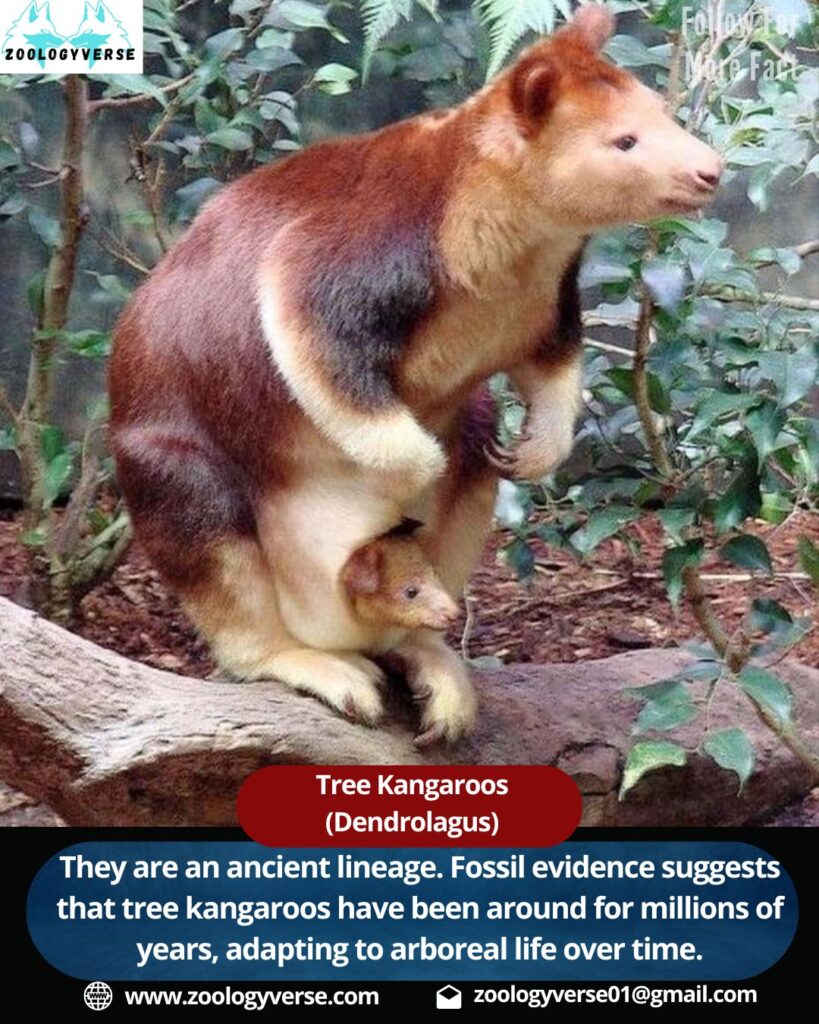
Scientific classification of Tree Kangaroo (Dendrolagus)
- Kingdom: Animalia
- Phylum: Chordata
- Class: Mammalia
- Infraclass: Marsupialia
- Order: Diprotodontia
- Family: Macropodidae
- Genus: Dendrolagus
There are around 14 recognized species within the genus Dendrolagus, including Goodfellow’s, Matschie’s, and Bennett’s species.
Here’s information on notable species within the genus Dendrolagus:
Notable Species of Dendrolagus
- Goodfellow’s (Dendrolagus goodfellowi)
- Recognizable by its golden-brown fur with two distinctive golden stripes running down its back.
- Native to the lowland and mid-mountain rainforests of Papua New Guinea.
- Listed as Endangered due to habitat loss and hunting.
- Matschie’s (Dendrolagus matschiei)
- Found only in the Huon Peninsula of Papua New Guinea.
- Distinguished by its reddish-brown coat with a pale underside and golden tail.
- Considered Endangered, mainly due to deforestation.
- Bennett’s (Dendrolagus bennettianus)
- The largest species, native to northeastern Queensland, Australia.
- Features dark brown fur and lives in high-altitude rainforests.
- Near Threatened, with a stable but limited population.
- Doria’s (Dendrolagus dorianus)
- A stockier species with thick fur, found in the mountain forests of Papua New Guinea.
- Has a shorter tail and prefers a more terrestrial lifestyle compared to others.
- Vulnerable due to hunting pressures.
- Lumholtz’s (Dendrolagus lumholtzi)
- One of the smallest species, found in Queensland, Australia.
- Dark brown to grayish fur with a distinct face pattern.
- Near Threatened, with populations declining due to habitat fragmentation.
- Grizzled (Dendrolagus inustus)
- Named for its grizzled gray-brown coat, making it unique among its relatives.
- Found in both Papua New Guinea and some nearby Indonesian islands.
- Least Concern, though populations are still affected by hunting.
There are additional lesser-known species, including the Tenkile (Dendrolagus scottae), Seri’s (Dendrolagus stellarum), and Ifola (Dendrolagus notatus), many of which are critically endangered and in need of urgent conservation efforts.
Habitat and Distribution
They inhabit the dense tropical rainforests of New Guinea, northeastern Queensland in Australia, and surrounding islands. These rainforests provide them with ample food and shelter, allowing them to thrive in the treetops.
Different species of tree kangaroos occupy various elevations, from lowland forests to mountainous regions above 10,000 feet (3,000 meters). Some of the well-known species include:
- Goodfellow’s tree kangaroo (Dendrolagus goodfellowi) – Found in Papua New Guinea.
- Bennett’s tree kangaroo (Dendrolagus bennettianus) – Native to Queensland, Australia.
- Matschie’s tree kangaroo (Dendrolagus matschiei) – Restricted to the Huon Peninsula in Papua New Guinea.
- Doria’s tree kangaroo (Dendrolagus dorianus) – Inhabits high-altitude rainforests.
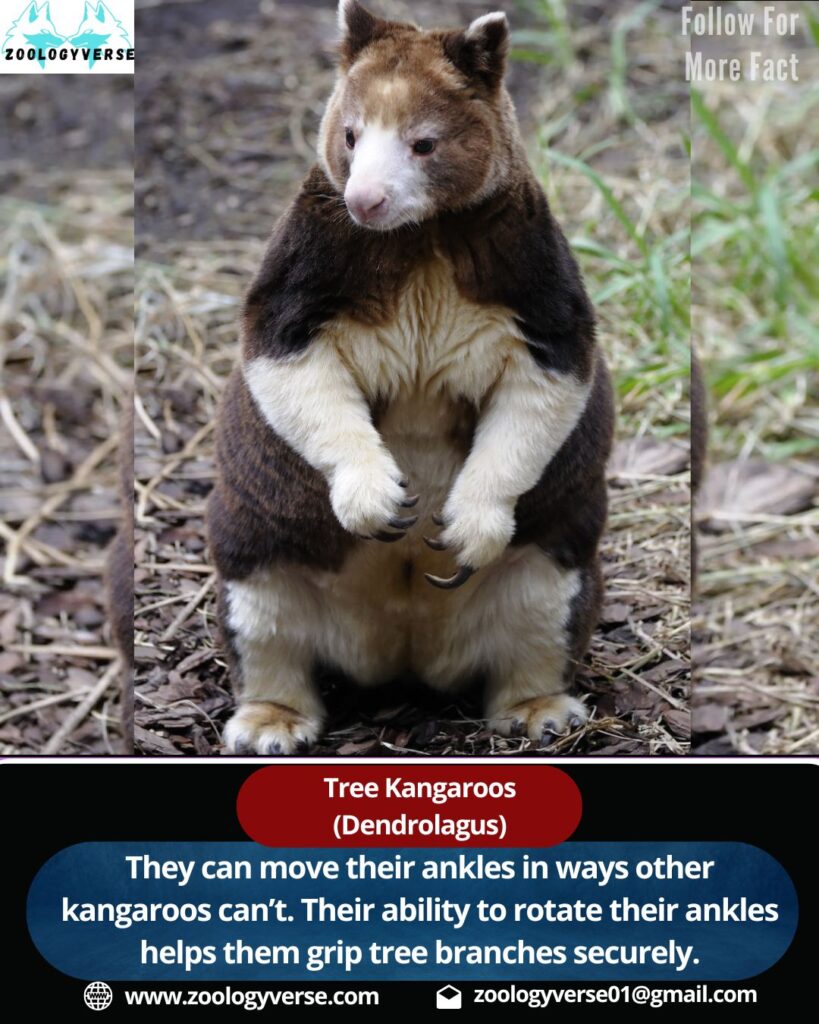
Diet and Feeding Behavior
Tree kangaroos are herbivores, with a diet consisting mainly of leaves, fruits, flowers, and tree bark. They are also known to consume ferns, moss, and occasional small invertebrates.
- Foraging habits: They primarily feed in the early morning and late afternoon.
- Digestive system: Tree kangaroos have a specialized stomach that helps them process fibrous plant material efficiently.
- Water intake: Most of their hydration comes from the moisture in leaves and fruits.
Their slow metabolism allows them to conserve energy while spending long periods resting in the trees.
Unique Adaptations and Behavior
They have evolved several adaptations that set them apart from their ground-dwelling relatives.
Arboreal Adaptations
- Strong limbs and curved claws for gripping tree branches.
- Long tail that provides balance while climbing.
- Flexible joints that allow them to rotate their ankles for better tree grip.
Movement and Locomotion
Unlike regular kangaroos that hop on the ground, tree kangaroos move differently:
- They climb vertically by gripping tree trunks and using their powerful limbs to pull themselves up.
- On the ground, they move with a clumsy hopping gait but can leap up to 30 feet (9 meters) from tree to tree.
Social Behavior
- Tree kangaroos are mostly solitary animals, except during mating or when mothers are raising their young.
- They mark their territory with scent glands to keep intruders away.
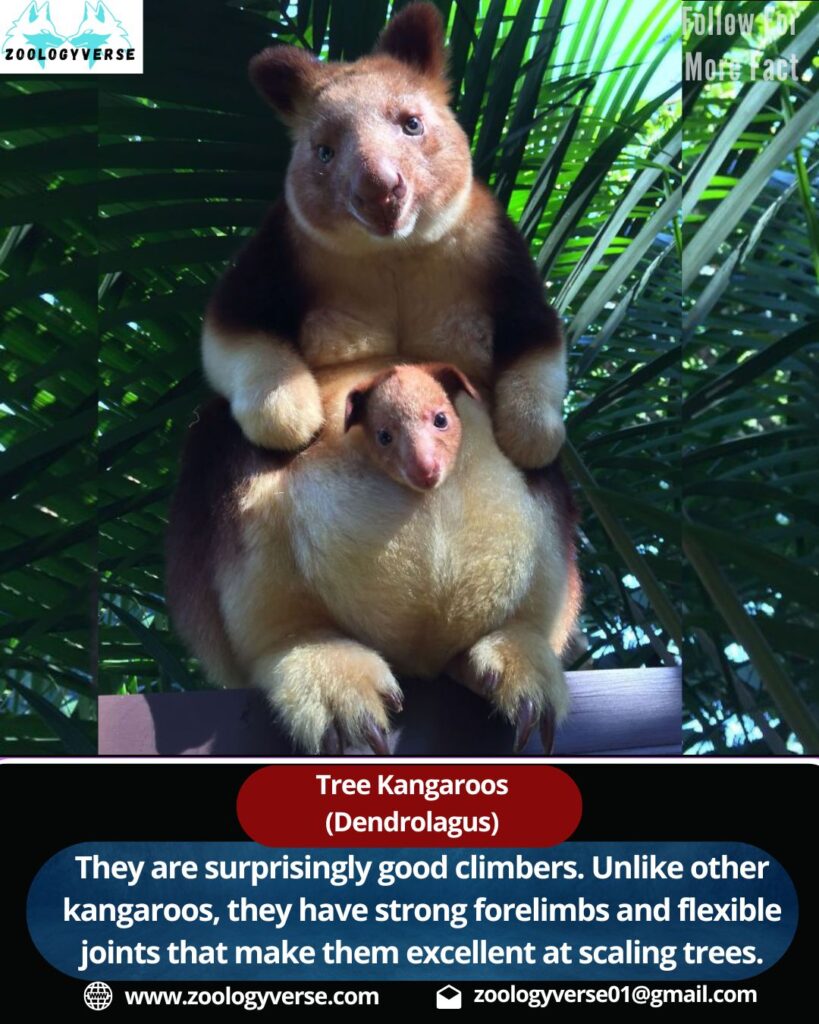
Reproduction and Life Cycle
Tree kangaroos, like all marsupials, give birth to underdeveloped young that complete their development in the mother’s pouch.
- Gestation period: About 30-40 days.
- Joey development: After birth, the tiny joey crawls into the mother’s pouch and remains there for 6-9 months.
- Weaning: Juveniles stay with their mother for up to 18 months before becoming independent.
A female tree kangaroo usually gives birth to one joey at a time, ensuring that she can provide proper care and nutrition.
Threats and Conservation Status
Unfortunately, many species of tree kangaroos are endangered or vulnerable due to various threats:
Major Threats
- Deforestation – Habitat destruction from logging, agriculture, and urban expansion is the biggest threat.
- Hunting – In some regions, tree kangaroos are hunted for food and fur.
- Climate Change – Rising temperatures and habitat fragmentation are affecting their survival.
Conservation Efforts
Several organizations and governments are working to protect tree kangaroos:
- Protected reserves and national parks have been established in Papua New Guinea and Australia.
- Breeding programs in zoos help increase population numbers.
- Community-based conservation initiatives aim to reduce hunting and promote sustainable practices.
Some conservation organizations involved in protecting tree kangaroos include the Tree Kangaroo Conservation Program (TKCP) and WWF (World Wildlife Fund).
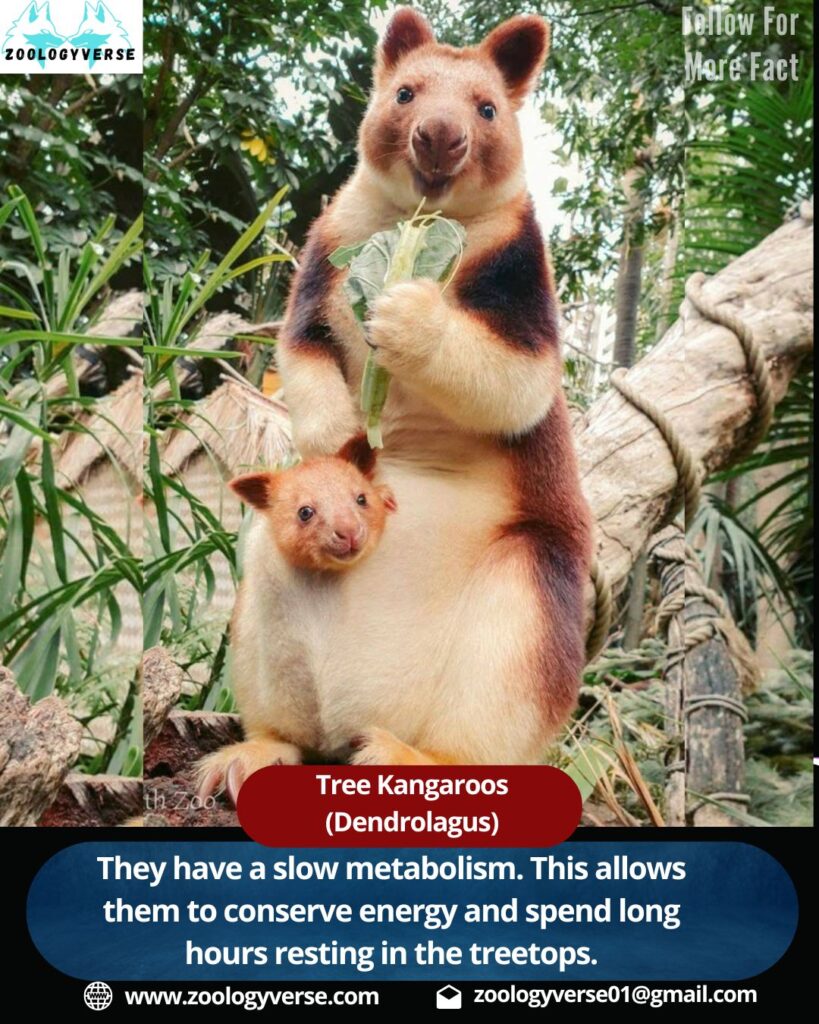
Why Are Tree Kangaroos Important?
Tree kangaroos play a vital role in rainforest ecosystems:
- Seed Dispersal: By eating fruits and defecating seeds, they help regenerate forests.
- Biodiversity Indicators: Their presence indicates the health of the rainforest.
- Ecotourism: They attract tourists, which can benefit local economies and conservation efforts.
Protecting tree kangaroos ensures the survival of an entire ecosystem, supporting countless other species.
Fun Facts About Tree Kangaroos
- They can jump extreme distances. Tree kangaroos can leap up to 30 feet (9 meters) from tree to tree!
- They are surprisingly good climbers. Unlike other kangaroos, they have strong forelimbs and flexible joints that make them excellent at scaling trees.
- They have a slow metabolism. This allows them to conserve energy and spend long hours resting in the treetops.
- Each species has unique markings. Some tree kangaroos have striking golden bands or pale bellies that distinguish them from others.
- They can move their ankles in ways other kangaroos can’t. Their ability to rotate their ankles helps them grip tree branches securely.
- They are marsupials. Just like their ground-dwelling relatives, tree kangaroos give birth to tiny joeys that develop inside their mother’s pouch.
- They are an ancient lineage. Fossil evidence suggests that tree kangaroos have been around for millions of years, adapting to arboreal life over time.
Tree kangaroos are truly one of nature’s marvels—remarkable climbers that have adapted to a life among the trees. Despite facing numerous threats, ongoing conservation efforts are giving these unique marsupials a fighting chance.
The rainforests of Papua New Guinea and northeastern Australia are home to some of the most extraordinary and unique marsupials in the world. Among them is a species that has mastered the art of arboreal living, showcasing a blend of agility, strength, and adaptability that sets it apart from its ground-dwelling relatives. These fascinating creatures, with their strong limbs, long tails, and gripping claws, are perfectly designed for life among the treetops.
As key contributors to their ecosystem, they play a crucial role in maintaining the balance of their habitat. By feeding on a diverse range of plant matter, they aid in seed dispersal, helping to regenerate the forests that house countless other species. Their presence is an indicator of a healthy, thriving ecosystem, yet they face growing threats that endanger their survival.
Habitat destruction caused by deforestation, agriculture, and human expansion is one of the biggest challenges they face today. As forests shrink, their ability to find food, shelter, and mates becomes increasingly difficult. In addition, hunting in certain regions has placed further pressure on their populations. Climate change also poses a long-term threat, altering the delicate balance of their environment and making survival even more challenging.
Despite these challenges, there is hope. Conservation efforts, including habitat protection, breeding programs, and community-driven initiatives, have helped bring attention to their plight. National parks and reserves provide safe havens where they can thrive, while research and education continue to raise awareness about the importance of preserving their species. By supporting conservation programs, spreading awareness, and advocating for sustainable practices, we can contribute to the long-term survival of these remarkable animals.
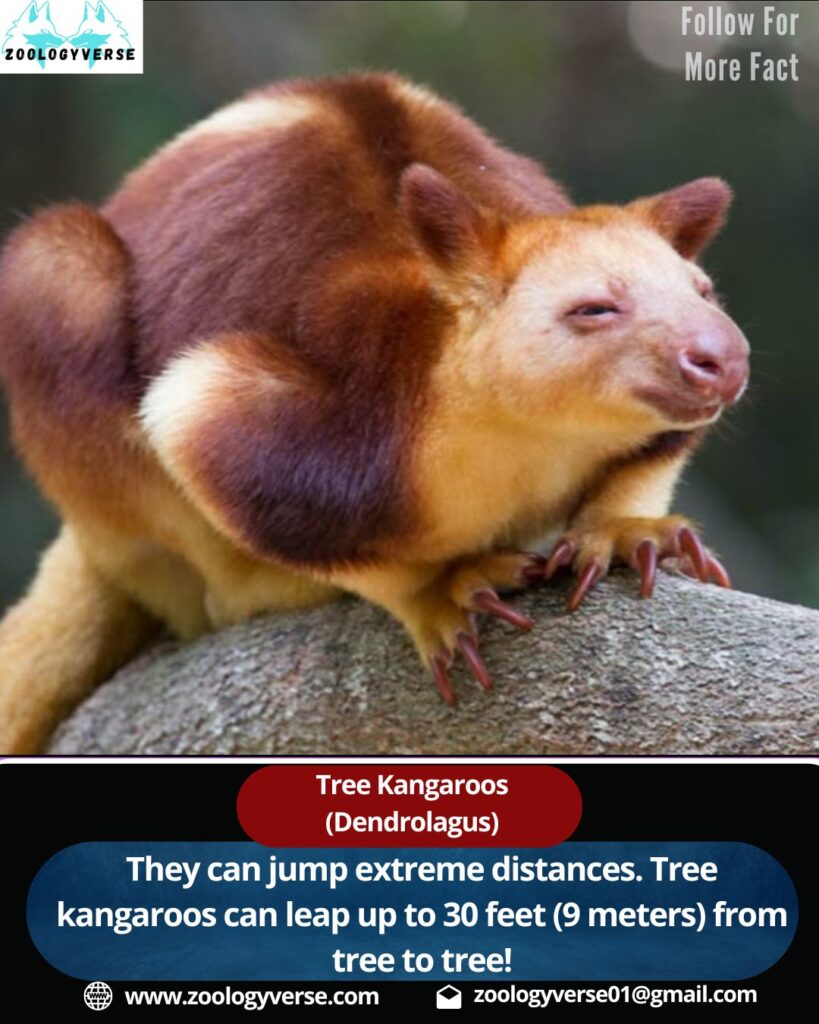
Protecting them is about more than just saving a single species—it’s about preserving the biodiversity of the forests they call home. Every effort made to safeguard their future helps ensure that the lush rainforests they inhabit continue to flourish for generations to come. Their survival is a testament to the resilience of nature, but it ultimately depends on the actions we take today. Through education, awareness, and conservation, we can make a difference and ensure that these extraordinary creatures remain a vital part of our planet’s rich biodiversity.
By raising awareness and supporting conservation programs, we can help protect tree kangaroos and their rainforest habitats for future generations.
For more in-depth articles on wildlife, marsupials, and conservation, visit ZoologyVerse!
Follow us on Instagram and Facebook
Frequently asked questions (FAQs) about tree kangaroos along with their answers:
1. What makes tree kangaroos different from regular kangaroos?
Tree kangaroos are adapted for life in the trees, unlike ground-dwelling kangaroos. They have stronger forelimbs, curved claws for climbing, and a long tail for balance. Their ankle joints are also more flexible, allowing them to grip branches better.
2. Where do tree kangaroos live?
Tree kangaroos are primarily found in the rainforests of Papua New Guinea, northeastern Australia, and some nearby islands. They inhabit both lowland and mountainous forests.
3. What do tree kangaroos eat?
They are herbivores, mainly feeding on leaves, fruits, flowers, and tree bark. Some species may also eat ferns, moss, and occasional small invertebrates.
4. Are tree kangaroos endangered?
Yes, many species of tree kangaroos are classified as endangered or vulnerable due to habitat destruction, hunting, and climate change. Conservation efforts are in place to protect them.
5. How high can tree kangaroos jump?
Tree kangaroos can leap up to 30 feet (9 meters) between trees! They are incredibly agile climbers and can descend from heights by hopping down branch to branch.
6. Do tree kangaroos have pouches like regular kangaroos?
Yes! Like other marsupials, female tree kangaroos have a pouch where their tiny joeys develop after birth.
7. Can tree kangaroos move on the ground?
Although they are adapted for climbing, tree kangaroos can move on the ground with a slow, clumsy hopping gait. Unlike terrestrial kangaroos, they can move their hind legs independently while walking.
8. How long do tree kangaroos live?
In the wild, they can live around 10-15 years, while those in captivity can live up to 20 years with proper care.
9. Why are tree kangaroos important to the ecosystem?
They help with seed dispersal, contributing to rainforest regeneration. Their presence also supports biodiversity within their habitat.
10. How can we help protect tree kangaroos?
Supporting conservation programs, reducing deforestation, and spreading awareness about these unique marsupials are key ways to help protect them. You can also donate to organizations that work to conserve their habitats.
